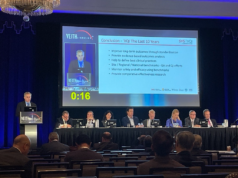
“Everything depends on the symptoms,” Aleksandra Jaworucka-Kaczorowska, of the Center of Phlebology and Aesthetic Medicine and the Center of Surgery, Gynaecology and Obstretics in Gorzów Wielkopolski, Poland, stresses in an interview on pelvic venous incompetence with Venous News.
“Your decision should be based on the pelvic symptoms, not the images,” Jaworucka-Kaczorowska elaborates, sharing her advice on how best to determine the most effective treatment plan for a patient with pelvic venous incompetence. She notes that the varying nature of symptoms for pelvic venous incompetence makes this strategy necessary, noting for example that pelvic-origin varicose veins can be present without pelvic symptoms. In addition, Jaworucka-Kaczorowska highlights that in many cases patients are asymptomatic, and do not require any pelvic diagnosis or treatment at all.
In the patients who do experience pelvic symptoms due to pelvic venous incompetence, Jaworucka-Kaczorowska explains, the best option is to embolise, citing “very good” results for this treatment option. She mentions in particular one systematic review that showed 70–100% of patients reported some degree of symptom improvement with embolisation, and another in which 75% of patients said that embolisation relieved their pelvic symptoms.
In other situations, however, such as when a patients has varicose veins of pelvic origin without pelvic symptoms, Jaworucka-Kaczorowska points out that embolisation would not be the treatment of choice. Instead, the best option would be to treat from below, she says, for example with sclerotherapy of pelvic escape points and related varicose veins.
Jaworucka-Kaczorowska notes that new guidelines on the management of varicose veins from the European Society for Vascular Surgery, published in March of last year, recommend that patients with varicose veins of pelvic origin and without pelvic symptoms should be considered for treatment from below. “We should not do embolisation [in these patients],” she stressed. “Of course, when a patient has pelvic symptoms, you do the embolisation to reduce such symptoms,” Jaworucka-Kaczorowska reiterates. On this note, however, she stresses that the data indicate only about 10% of patients with varicose veins of pelvic origin has pelvic symptoms. For this reason, she explains, treatment from below is done more frequently and also done better.
Summarising her key message, Jaworucka-Kaczorowska highlights that “the most important thing” in pelvic venous incompetence patients is to “not treat images, treat symptoms” for good outcomes. Here she cites her clinical experience as a gynaecologist, noting that she sees many patients with varicose veins around the uterus that develop around the time of a first pregnancy. Around 10% of the general population will have varicose veins, she states, while the incidence increases to roughly 30% of women after once pregnancy and the figure increasing up to 60% by the fourth pregnancy. These statistics do not mean that all these patients need to be coiled, however, Jaworucka-Kaczorowska says.
Finally, she stresses that the possibility for complications after coil embolisation, such as migration, need to be taken into account when making deciding on the best treatment plan for a pelvic venous incompetence patient. “We have to choose wisely when we are selecting patients and do the proper diagnostic,” Jaworucka-Kaczorowska asserts.













How to avoid excessive diagnosis and treatment of pelvic venous incompetence
1- How to Assess Illusory May–Thurner Syndrome by Ultrasound
Paolo Zamboni
Claude Franceschi
Open ArchivePublished:May 31, 2019DOI:https://doi.org/10.1016/j.ejvs.2019.01.034
2- Illusory MTS
https://youtu.be/h931XXo2hdk
How to avoid excessive diagnosis and treatment of pelvic venous incompetence
Illusory MTS
https://youtu.be/h931XXo2hdk
How to avoid excessive diagnosis and treatment of pelvic venous incompetence
How to Assess Illusory May–Thurner Syndrome by Ultrasound
Paolo Zamboni
Claude Franceschi
Open ArchivePublished:May 31, 2019DOI:https://doi.org/10.1016/j.ejvs.2019.01.034